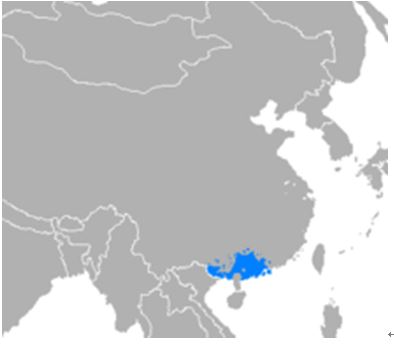Cantonese Translation

Cantonese (or Yue) is one of the five major Chinese languages. These are often called "dialects", but in actuality their differences are great enough to consider them separate languages.
Cantonese is spoken by about 100 million people in the southern provinces of Guangdong and Guangxi and in neighboring areas such as Hong Kong and Macao, as well as throughout South-East Asia in such places as Singapore, Malaysia, Thailand and Vietnam. Due to the migration of Cantonese speakers from Hong Kong and the Guangdong area, Cantonese is the dominant form of Chinese spoken in the Chinatowns of many major cities in the United States, Canada, Australia and elsewhere.
The word Cantonese comes from Canton, the former English name of Guangzhou, capital of Guangdong, which was once considered the home of the purest form of Cantonese. However, through years of mass media and pop culture influence, Hong Kong has now truly become the cultural centre of Cantonese.
Although Mandarin (or putonghua) is the standard and official language in mainland China, it has only been around for about 700 or 800 years, compared to the 2000-year history of Cantonese. Cantonese, not Mandarin, is the dominant language in overseas Chinese communities. This comes from the fact that, around the world, the largest flow of Chinese immigrants originates from Hong Kong.
Cantonese is mainly an oral language. People in Hong Kong use standard Chinese (putonghua) when they read and write. They speak Cantonese in their daily interactions with people. As a colloquial language, Cantonese is full of slang and non-standard usage. The language of youth is rapidly evolving, and new slang and trendy expressions are constantly emerging.
The standard written language in Hong Kong is essentially the same Chinese as everywhere else in China. The only difference is that Hong Kong and overseas communities, like Taiwan, have kept what are called traditional characters, whereas mainland China uses simplified characters. In an attempt to increase litteracy in China, thousands of characters were "simplified" in a 1950 spelling reform initiated by chairman Mao Zedong.

Dialects
Standard Cantonese, also known as Guăngdōng dialect, refers to the most prestigious dialect spoken in Guăngzhōu (Canton), Hong Kong, and Macau.There are numerous other dialects of Cantonese, such as Bobai, Cangwu, Gaolei (Gaoyang), Guangzhou, Guinan, Ping, Qinlian, Siyi (Hoisan, Schleiyip, Seiyap, Taishan, Toisan), Tengxian, Yangjiang, Zhongshan (Ethnologue).
Sound system
Cantonese is considered to be a conservative dialect, its sound system having preserved the final consonants and tones of the Tang Dynasty literary standard.
Syllable structure
Syllables in Cantonese consist of an Optional Initial Consonant + Vowel (accompanied by tone) + Optional Final Consonant (/n/, /ŋ/, /m/, /p/, /t/, /k/). In contrast, Mandarin allows only /n/ and /ŋ/ in final position.
Grammar
Cantonese, like all other Chinese languages, is predominantly an isolating, or analytic, language, meaning that for the most part, words have only one grammatical form. Grammatical functions are expressed through word order, particles, prepositions, and discourse, rather than by suffixes attached to nouns or verbs, such as in Indo-European languages. Because of the lack of inflections, Chinese grammar may appear quite simple as compared to that of Indo-European languages.
Noun phrase
• Number and gender are not marked grammatically, except in pronouns and polysyllabic nouns referring to people. Otherwise, they are understood through context.
• Cantonese nouns require classifiers when counted. Hence one must say ‘two [head] cow’, not ‘two cows’. Each noun has one classifier. There are dozens, if not hundreds, of classifiers that must be memorized for various classes of nouns, e.g., round objects, flat objects, book-like objects, animate beings, etc.
Verb phrase
• Tenses are not marked grammatically, rather they are indicated by adverbs of time, e.g., ‘yesterday’, ‘today’, ‘now’.
• Aspect is marked by particles that indicate completion of an action or change of state.
• Mood is marked by modal particles.
Syntax
Like Mandarin, Cantonese is a topic-prominent language. This means that the topic of the sentence (defined as old or known information) precedes new or added information. In Cantonese, direct objects precede indirect objects, and certain adverbs precede verbs, while the opposite is true in Mandarin.
Cantonese words in English
English has borrowed a number of words from Cantonese. Below are a few of them.
|
Chop suey |
from Cantonese tsap sui ‘odds and ends’ |
|
Dim sum |
from Cantonese dim sam ‘appetizer’ |
|
Kumquat |
from Cantonese kamkwat, from kam ‘golden’ + kwat ‘orange’ |
|
Tea |
from Malay teh, or directly from Amoy dialect of Chinese t’e. The Mandarin word is chá. The distribution of the different form of the word reflects the spread of the beverage. The modern English form tea, along with French the, Spanish te, GermanTee, etc., derive via Dutch thee from the Amoy dialect. The Portuguese form cha, Russian chai, Arabic shay, and Turkish çayall came from the Mandarin form chá. |
|
Tycoon |
From Cantonese tai ‘great’ + kiun ‘lord’. |
|
Tong |
‘Chinese secret society’, from Cantonese tong ‘assembly hall’ |
How much does a translation into Cantonese cost?
The standard rate for translations from English into Cantonese is $ 0.12. For urgent jobs that need several linguists working simultaneously, we will apply a surcharge.
Just contact us to get more information and a no-obligation quote. Our project managers can be reached via telephone, email, or the form. We look forward to serving you.
For more information about Cantonese Translation,
call us or add wechat today at +86-18206071482
or send us an email to:info@target-trans.com